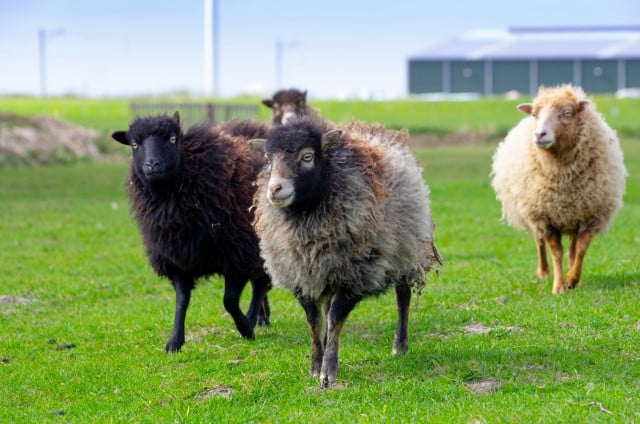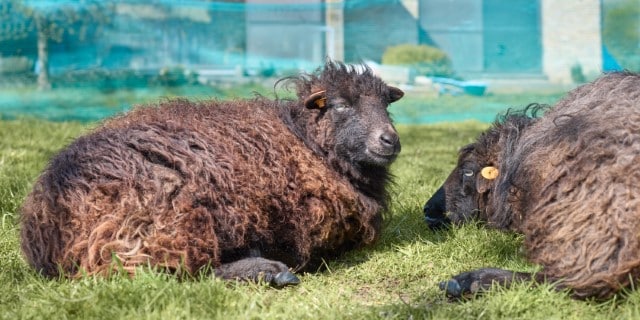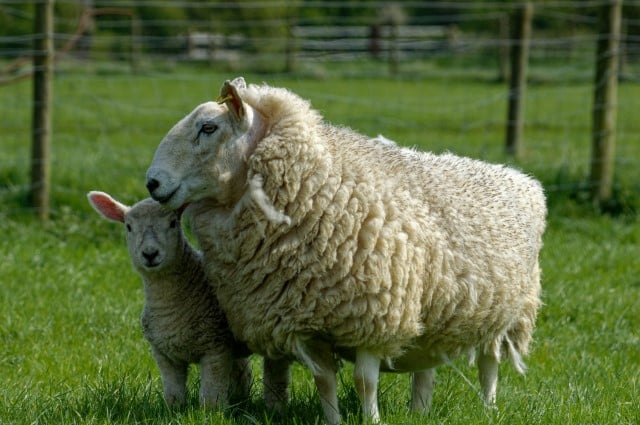If you don’t know much about sheep, maybe you think there are only a few different sheep breeds and that they’re all a similar size. But the truth is that there are hundreds of sheep breeds and some of them are much smaller than you might imagine. Let’s take a look at some small sheep breeds, including the smallest breed of sheep in the world.
The Ouessant is the Smallest Sheep Breed
Experts recognize the unique Ouessant sheep as the smallest breed of sheep on the planet. In fact, the ram’s height at the shoulder averages a mere 19 inches. The average measurement for ewes is 18 inches, but they can be significantly smaller.

In fact, an adult Ouessant as small as 14 inches at the shoulder has been recorded. The Ouessant is different form some other miniature and rare breeds in that it has dark wool.
Most Ouessants have dark brown or black fleeces. White sheep are quite rare in this breed.
The Ouessant was originally developed on the island of Ouessant, which is situated near Brittany in France. Until the 1970s, this sheep breed was the only type of sheep raised and farmed on this island.
It was only a little over 100 years ago that this sheep was kept anywhere else. Some people call the Ouessant the “Breton Dwarf.”
This sheep breed has thick wool and has many practical purposes, such as spinning yarn for clothing.

If you have a hobby farm and want a tiny breed of sheep, take a look at the Ouessant. You won’t have to worry about having large pastures, and these sheep are friendly and docile.
In fact, if you have never owned and kept sheep before, and are looking to start a sheep farm, then you can start out with the Ouessant. It’s also fantastic if you have a relatively small space, although every kind of sheep does, of course, need outdoor space. Sheep don’t make good pets.
Ouessants have thick and dense wool, a trait they developed because of the cool and stormy weather of their native Isle of Ouessant.
If you want to keep Ouessant sheep, you will enjoy their lovely wool after each shearing. This sheep breed is clever and full of personality.
Other Small Sheep Breeds
Of course, the Ouessant isn’t the only small sheep breed. Below are some other tiny breeds of sheep that you can find.
Miniature Cheviot Sheep
Miniature cheviot sheep are certainly small sheep. Once they’ve reached two years old, their greatest possible height at the withers is usually 23 inches.

A fully mature ram weighs as little as between 55 and 100 pounds. An ewe in this breed will weigh 45 to 85 pounds.
The miniature cheviot is a polled sheep. This means neither the ram nor ewe has horns.
You won’t find any wool on their faces or legs. However, this sheep has a cute wool ruff behind the ear area.
There are different facial varieties within the miniature cheviot breed, with some individuals having a very straight profile and others appearing to have a Roman nose.
This sheep breed has tiny, perky ears, and wider than average faces.
The miniature cheviot sheep has black hooves, noses, and rims of the eyes. You can find miniature cheviot sheep in many different wool colors.
For example, you may find sheep of this breed with silver, light beige, white, and black wools. The miniature cheviot produces wool that has little grease and long staples.

The wool is dense and has a soft hand.
The miniature cheviot’s personality is equal parts lively and friendly. This sheep makes a good first breed if you have an appropriate property, such as a small and/or hobby farm, though I’d personally recommend beginners choose a more docile breed.
Unlike other miniature sheep breeds, the miniature cheviot was never bred specifically to be small. In fact, what we know today as the miniature cheviot is simply what used to be the standard cheviot breed.
It was when cheviots started being used for meat that producers started selecting for larger size. The resulting sheep ended up being classed as a standard cheviot, while the historic cheviot took on the name of miniature cheviot.
Babydoll Southdown Sheep
Another tiny sheep is the Babydoll Southdown sheep.
Even as adults, this breed of sheep will weigh somewhere between 60 and 125 pounds. Their height as adults is between 18 and 24 inches.
Of course the best examples of the breed, raised for show, may be larger.

Many people living on farms and large properties like keeping Babydoll Southdown sheep. In fact, many people get them for their kids when they start their 4-H sheep project.
Make sure you always keep any kind of sheep properly protected with fencing.
One of the most attractive features of the Babydoll Southdown Sheep is its adorable little face. It’s quite distinctive from other sheep.
This is especially true for the babies. The Babydoll Southdown sheep is a polled breed, meaning neither the rams nor ewes have horns.
This is a friendly and calm sheep breed, and they get along well with many other kinds of animals. This sheep can be a bit timid, so be patient.
The Babydoll Southdown sheep is famous for its wonderfully soft wool, which many people have compared to cashmere.
As the Babydoll Southdown sheep is so small, it doesn’t need as much food as many other sheep breeds. Their excellent metabolism contributes to how easy it is to keep and feed a Babydoll Southdown sheep.
This sheep breed enjoys eating broadleaf weeds called forbs, which is helpful on many properties.
North Ronaldsay Sheep
This sheep breed has been around for many centuries, and it’s a strong and dependable variety. North Ronaldsay Sheep are versatile and adaptable.
In fact, where they live on Atlantic Ocean islands and in northern Europe, seaweed is sometimes their only food. They find the seaweed that comes in with the high tide.

North Ronaldsay is an island where North Ronaldsay sheep are prevalent. It’s situated in the North Sea, off the coast of Orkney in Scotland.
North Ronaldsay sheep on that island have eaten seaweed for thousands of years, even when they were given other food by farmers and shepherds.
The North Ronaldsay Sheep has been crucial for the survival of people living in its native environments since ancient times.
In the mid-19th century, however, economic and cultural changes meant that larger sheep breeds were brought in. These ended up pretty much replacing the North Ronaldsay sheep when it came to wool and meat production.
The North Ronaldsay sheep live wild in their native habitats, but communal farmers and shepherds still gather and shear them on a regular basis.
Learn How to Care for Sheep
Don’t assume that just because a sheep is tiny that you won’t have to know how to take care of it like other sheep, or that it would make a good pet.
Miniature sheep still need outdoor space and the right kinds of grazing and food. Once you have decided on the sheep breed that would best fit your preferences and/or operation, find out the proper diet and care regimen.

In rural areas, it’s quite common for parents to buy miniature sheep for their kids as pets or projects to learn about sheep-rearing and farming.
This is a great idea, but make sure you monitor how your child takes care of the sheep. Ensure that the animal gets all the food and care that it needs.
I have an entire section of my site dedicated to getting started with a 4H sheep project for kids which you should check out if you’re interested.
Final Thoughts: Smallest Breed of Sheep
The smallest sheep breed in the world is the Ouessant. Other tiny sheep are the Miniature Cheviot Sheep, the Babydoll Southdown Sheep, and the North Ronaldsay Sheep.
No matter what kind of sheep you have, you must provide it with outdoor space, proper housing and appropriate care.
If you’re thinking about getting a small breed of sheep because you have a hobby farm, don’t forget that this is still a farm animal that needs plenty of time in the outdoors.

